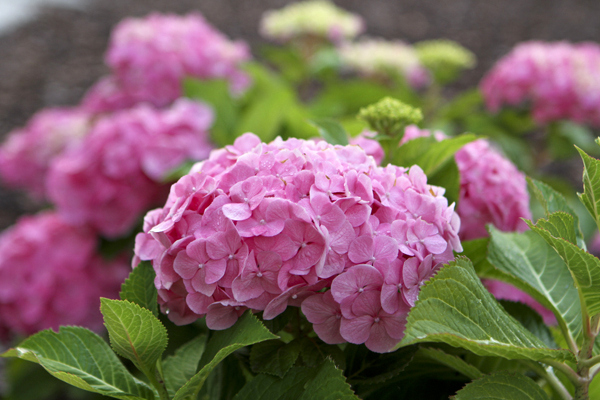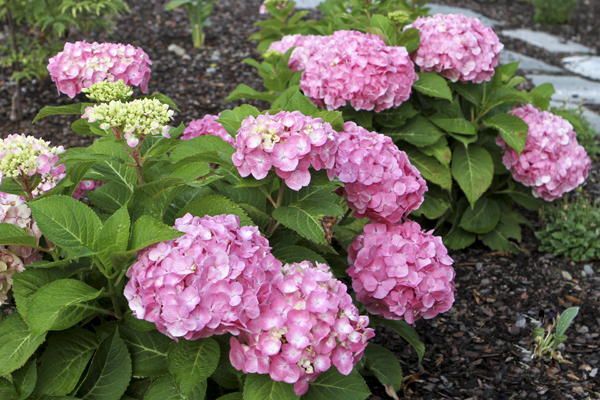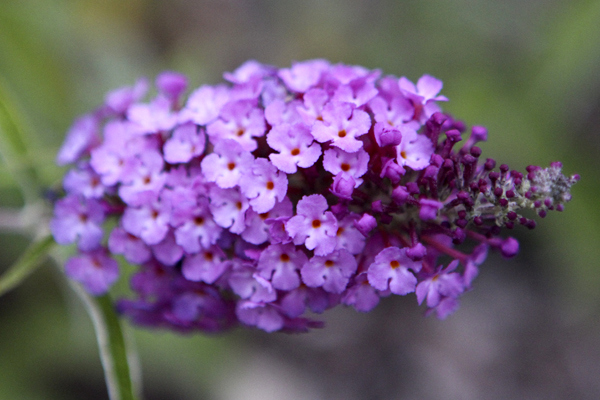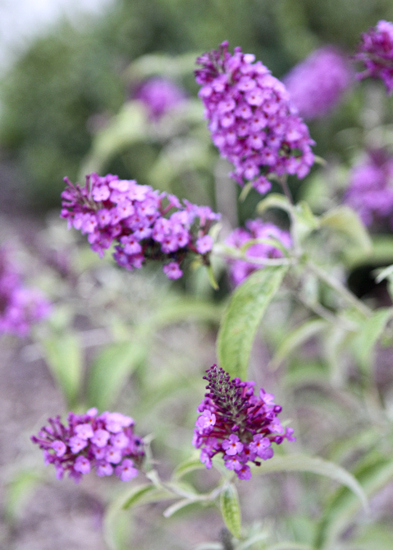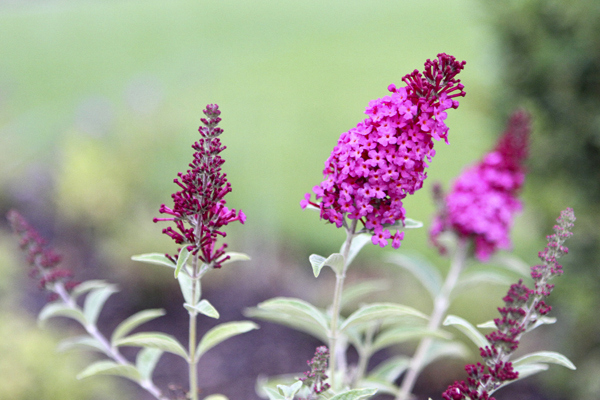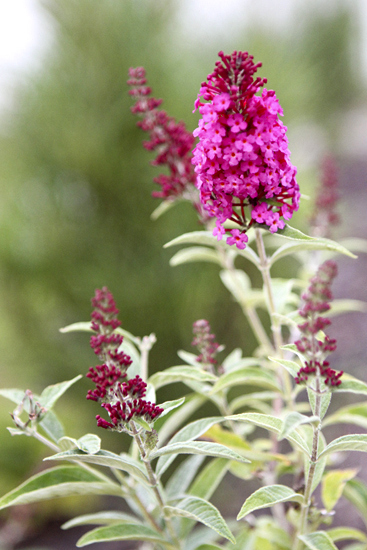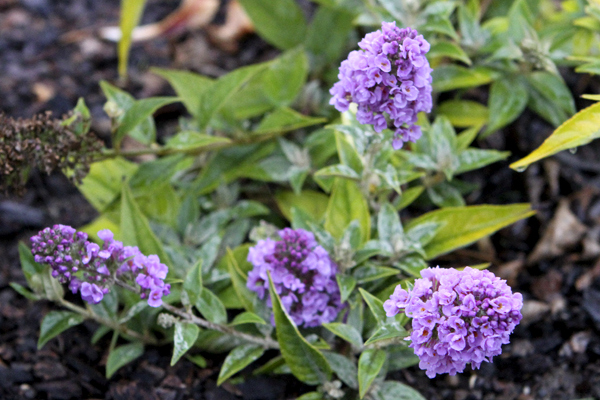
Four months after our big landscaping project, there are some pretty views but still a lot of bare soil in our backyard. The view above is facing south from just inside the backyard. You can see the older section of path where creeping thyme has filled in between the stones and the newer section of path where tiny clumps of creeping corsican mint are just starting to expand.

Here is the view from the entrance gate looking north. A columnar 'Green Tower' boxwood stands on the left of the path. Maroon-leaved 'Royal Raindrops' crabapple trees beckon from the far corner. You see how the neighbor's aspen trees are making a nice screen? After building that big root barrier to keep their aggressive roots from invading our yard, I'm enjoying the fluttering aspen leaves and the additional privacy they give us. I still have to pull up baby aspens that have sprouted from the few root sections that were left in our yard. I'm so glad we spent the money to prevent additional roots from growing into my garden.
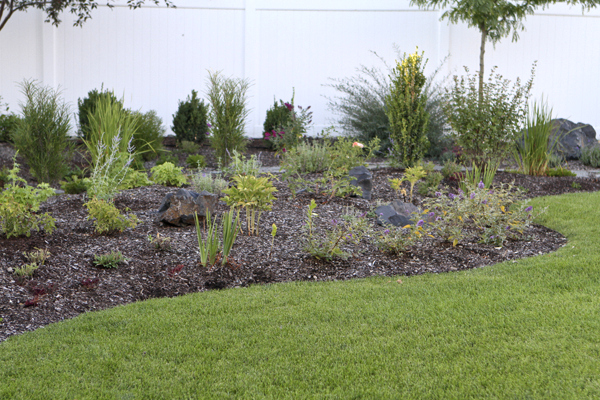
Moving down the path, a look to the right shows the mostly barren main sunny bed. Eventually this should fill in with billowing roses, delphiums, butterfly bushes, and Russian sage, but right now everything is spindly and there aren't many flowers.

After rounding the NW corner curve, a look back down the path shows spiky siberian iris (thanks Kathy!) and 'Fine Line' buckthorn. Since I'm allergic to grasses - they cause sneezing and a rash - I have used a lot of siberian iris, Japanese iris and rushes to add grassy texture to the gardens.

The dwarf arctic willow on the left has grown a lot this year. I plan to prune it almost down to the ground every spring or two. This will keep it from getting too large and will cause plenty of new stems to grow. The young maroon stems are pretty in the winter.

Here is the view looking back down the path. Little lavender shrubs bask in the reflected heat on the south side of the boulder. In the distance, 'Victoria' rhubarb leaves make a dramatic impact. I planted the rhubarb for its big leaves, though we can eat the stems if we want. I haven't dedicated a spot for food gardening, but we have herbs like parsley and oregano tucked into the beds. I have mint in pots on the patio and plan to add some 'Peach Sorbet' blueberries to the beds when they're available at the nursery next spring.

Here is a the same view from farther east. Baby 'Green Velvet' boxwoods flank the path where it runs into the grass. The chartreuse leaves of a 'Sutherland Gold' elderberry are out of focus on the right. These wide landscape shots are trickier than close ups. I suppose it would have been better to get everything in focus, eh?

Here is the current view of the NE corner. I love our benches. We have three of this style, and I noticed the same bench in photographs of the David Austin Rose Gardens in England. I'm pretty sure his bench cost more and didn't come from Lowe's. Perfectly pink 'Big Easy' hydrangeas remind me of cupcakes on the right.

Here is the same corner from the south. The 'Shasta' doublefile viburnum in the corner has grown quite a bit this year, but it still has a ways to go before it fills the whole corner at a mature size of 6' tall and 10' wide. 'Green Mountain' boxwoods and 'Little Lime' hydrangeas are staggered along the fence line on the right of the photo.

The shade garden right next to the house is full since I didn't have to transplant much in that area during the landscaping this spring. The 'Stellar Pink' dogwood at center is finally growing after just sitting there for a few years. Unfortunately for the tree we just met with an architect about pushing out our dining room wall, which will require moving the patio into the area pictured. That means we'll have to transplant the poor tree. Poor planning on my part.

Here is a view of the white garden, which currently looks sickly pale because the plants didn't have time to establish many roots after being transplanted there in April. It got hot soon afterward and the plants have just been surviving ever since. Hopefully they'll get those roots out next spring and look healthier next summer.

And here is a final shot of the section of path that runs down the east side of the house to the side garage door. The far corner is filled with pots of plants awaiting homes, though eventually I hope to get it cleaned out and start a compost pile there.
Although I feel impatient for the garden to fill in and cover all that bare soil with pretty leaves, I have to admit it doesn't look too bad when considering that nearly everything was planted or transplanted just four months ago. But I'm still looking forward to next year and eventually a mature - sigh - garden.
